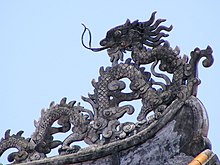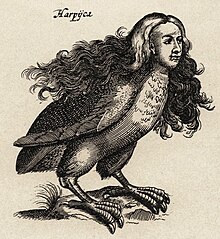| Revision as of 13:13, 24 March 2013 editJreferee (talk | contribs)Extended confirmed users20,390 edits Revised per talk page← Previous edit | Revision as of 13:15, 24 March 2013 edit undoTheRedPenOfDoom (talk | contribs)Pending changes reviewers, Rollbackers135,756 edits would exclude Bigfoot, Nessie, etcNext edit → | ||
| Line 5: | Line 5: | ||
| {{fantasy}} | {{fantasy}} | ||
| A '''legendary creature''' is an ], especially a nonhuman, whose life is accounted in nonhistorical or yet to be verified stories that sometime involve the ] |
A '''legendary creature''' is an ], especially a nonhuman, whose life is accounted in nonhistorical or yet to be verified stories that sometime involve the ]. | ||
| ==Origin== | ==Origin== | ||
Revision as of 13:15, 24 March 2013
This article is about creatures in mythology and folklore. For Legendary Creatures in Magic: The Gathering, see Legend (Magic: The Gathering).| This article needs additional citations for verification. Please help improve this article by adding citations to reliable sources. Unsourced material may be challenged and removed. Find sources: "Legendary creature" – news · newspapers · books · scholar · JSTOR (July 2008) (Learn how and when to remove this message) |
A legendary creature is an animal, especially a nonhuman, whose life is accounted in nonhistorical or yet to be verified stories that sometime involve the supernatural.
Origin

Some mythical creatures have their origin in traditional mythology and have been believed to be real creatures, for example angels, demons, dragons, griffins, and unicorns. Others were based on real encounters, originating in garbled accounts of travelers' tales, such as the Vegetable Lamb of Tartary, which supposedly grew tethered to the earth (and was actually a type of fern), or the Sukotyro, an elephant- and ox-like quadruped from Java, included in George Shaw's Zoology based on just one sighting in 1563.
Conversely, some creatures downplayed as just storytelling, have been rediscovered and found to be real in recent times, such as the Giant Squid (the Kraken). In Africa, Natives of the Congo told European visitors of an animal that looked like a cross between a zebra and a giraffe. While the visitors assumed the stories were just folk tales, in 1901, Sir Harry Johnston brought back pelts that proved the creature, which is now called the okapi, is real.
Modern researchers of mythology and folklore, like Adrienne Mayor, have theorized that some legendary mythical creatures were based on finds of real animal fossils by ancient civilizations. Dragon tales have been theorized to be based on finds of dinosaur fossils. Ancient miners all over the world probably found fossil skeletons of the extinct giant lizards in deep mines, leading to globally similar stories of dragons dwelling in caves. Cyclops have been theorized to be based on finds of dwarf elephant skulls by ancient Greeks. The dwarf elephant skull has a large opening located in the center upper front for the nasal cavity of the trunk. This opening resembles a centrally located eye socket of a gigantic person, leading to the stories of one eyed giants. Unicorn myths are theorized to be based on depictions of rhinoceros passed along and acquiring inaccuracies by being told by story tellers unfamiliar with the animal. The general description of a four legged beast with a large horn centered on its head might have been described as horselike, and over time depicted as such.
Hybrids

Often mythical creatures are hybrids, a combination of two or more animals. For example, a centaur is a combination of a man and horse, the minotaur of a man and bull, and the mermaid, half woman and half fish. These were not always intended to be understood as literal juxtapositions of parts from disparate species. Lacking a common morphological vocabulary, classical and medieval scholars and travelers would attempt to describe unusual animals by comparing them point-for-point with familiar: the giraffe, for example, was called camelopard, and thought of as a creature half-camel, and half-leopard. The leopard itself was so named as it was historically believed to be a half-lion (Latin: "leo") and half-panther (Latin: "pardus"). This etymology has been kept until the present day, despite its zoological inaccuracies.
Modern creatures
Other legendary creatures are thought to exist even today, but evidence is lacking. Famous examples are chupacabras, sasquatch, yeti, the Loch Ness Monster, Mermaid, and space aliens. These are called cryptids by cryptozoologists.
Cultural influence
In medieval bestiaries, legendary creatures are listed together with real animals. Throughout history legendary creatures have been incorporated into heraldry and architectural decoration.
Many legendary creatures appear prominently in fantasy fiction. These creatures are often claimed to have supernatural powers or knowledge or to guard some object of great value, which becomes critical to the plot of the story in which it is found. Dragons, for instance, are commonly depicted as perched on a gleaming hoard of gold which becomes the target of adventurers.
Legendary creatures have also been accepted into many facets of popular culture, most notably in fantasy role playing games such as Dungeons & Dragons, video games, and Hollywood movies.
See also
Notes
- Bascom, p. 9
- "myths", A Dictionary of English Folklore
- Large, Mark F. (2004). Tree Ferns . Portland, Oregon: Timber Press, Incorporated. p. 360. ISBN 978-0-88192-630-9.
{{cite book}}: Unknown parameter|coauthors=ignored (|author=suggested) (help) - "Mythical creature". New World Encyclopedia. Retrieved 2013-01-25.
References
- Bascom, William. "The Forms of Folklore: Prose Narratives". 'Sacred Narrative: Readings in the Theory of Myth. Ed. Alan Dundes. Berkeley: University of California Press, 1984. 5-29.
- "myths". A Dictionary of English Folklore. Jacqueline Simpson and Steve Roud. Oxford University Press, 2013. Oxford Reference Online. Oxford University Press. 23 March 2013 Oxfordreference.com
- O'Flaherty, Wendy. Hindu Myths: A Sourcebook. London: Penguin, 1975.
| Speculative fiction | |||||||||||||
|---|---|---|---|---|---|---|---|---|---|---|---|---|---|
| Science fiction |
| ||||||||||||
| Fantasy |
| ||||||||||||
| Horror |
| ||||||||||||
| General | |||||||||||||
| Related | |||||||||||||
| Heraldry | |||||||||||||||
|---|---|---|---|---|---|---|---|---|---|---|---|---|---|---|---|
| Types | |||||||||||||||
| Topics | |||||||||||||||
| Achievement | |||||||||||||||
| Charges |
| ||||||||||||||
| Tinctures |
| ||||||||||||||
| Applications | |||||||||||||||
| Related | |||||||||||||||
| |||||||||||||||